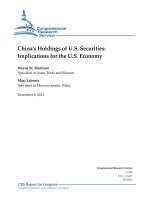fabrication of znscupva nanocomposite electroluminescence devices for flat panel displays
Bạn đang xem bản rút gọn của tài liệu. Xem và tải ngay bản đầy đủ của tài liệu tại đây (1.07 MB, 5 trang )
Research Article Adv. Mat. Lett. 2013, 4(2), 169-173 ADVANCED MATERIALS Letters
Adv. Mat. Lett. 2013, 4(2), 169-173 Copyright © 2013 VBRI press
www.amlett.com, www.amlett.org, DOI: 10.5185/amlett.2012.6374 Published online by the VBRI press in 2013
Fabrication of ZnS:Cu/PVA nanocomposite
electroluminescence devices for flat panel
displays
Sakshi Sahare
1
, S. J. Dhoble
2*
, Pranav Singh
1
, Meera Ramrakhiani
1
1
Department of Post Graduate Studies and Research in Physics and Electronics, Rani Durgawati University, Jabalpur, India
2
Department of Physics, R. T. M. Nagpur University, Nagpur 440033, India
*
Corresponding author. E-mail:
Received: 18 June 2012, Revised: 21 August 2012 and Accepted: 26 August 2012
ABSTRACT
The powder of ZnS nanoparticles were prepared by using chemical deposition technique and characterized by
electroluminescence techniques are reported in this paper. The estimated size of ZnS:Cu nanocrystals with change in capping
agent concentration and ZnS:Cu/PVA nanocomposites and no effect of doping has been observed on the absorption spectra.
Electroluminescence (EL) investigations of nanocrystalline powder as well as nanocomposites, it is seen that Log B vs. 1/V
curve is a straight line with negative slope. This indicates that EL is produced by acceleration-collision mechanism. The detail
EL characterization and application in display devices of these materials are reported in this paper. Copyright © 2013 VBRI
press.
Keywords: Nanoparticles; electroluminescence; lamp phosphor; ZnS:Cu; display devices.
Sakshi Sahare is assistant professor in Govt.
College Bichhua, Chhindwara (M.P.), India. She is
working on optical properties of copper doped zinc
sulphide nanocrystals. Her research interest is in
synthesis and characterization of inorganic materials
for lighting applications.
S.J. Dhoble obtained M.Sc. degree in Physics from
Rani Durgavati University, Jabalpur, India in 1988.
He obtained his Ph.D. degree in 1992 on Solid State
Physics from Nagpur University, Nagpur. He is
presently working as an Associate Professor in
Department of Physics, R.T.M. Nagpur University,
Nagpur, India. He is involved in the synthesis and
characterization of solid state lighting nanomaterials
as well as development of radiation dosimetry
phosphors using thermoluminescence,
mechanoluminescence and lyoluminescence
techniques. He published several research papers in
International reviewed journals on solid-state
lighting, LEDs, radiation dosimetry and laser
materials. He is an executive member of
Luminescence Society of India.
Pranav Singh is presently working as computer
programmer in Department of Postgraduate studies
and Research in Physics and Electronics, R.D.
University, Jabalpur, India. His field of research is
Condensed Matter Physics: Luminescence & Optical
properties, Nanomaterials and nanotechnology, Photovoltaic effects,
Electronic & optical properties of semiconductor (OLED’s), Advances in
Artificial Intelligence, Expert Systems. He has published sixteen research
papers in International Journals, National Conferences and Seminars.
Meera Ramrakhiani is presently Professor and
Head, Departemnt of Physics and Electronics,
Rani Durgavati University Jabalpur. She has done
her graduation, M.Sc.and Ph.D from the
University of Jabalpur (now Rani Durgavati
University) and has 35 years of teaching
experience at under graduate and post graduate
level. Fifteen students have completed their Ph.D.
under her supervision and many more are working
in the field of nanomaterials, luminescence and
photovoltaic solar cells. She has participated in
about 50 seminars/symposia etc. and presented has work at national/
International level. She has visited Italy, Hungary, Singapore, USA and
China for the research work. About 300 published papers are there to her
credit. She has successfully carried out two research project funded by
MPCST. Dr. M.Ramrakhiani has received Vijaya Shree Award by India
International Friendship Society in 1997, The 20
th
Century Award of
Achievement by International biographical Center, Cambridge, England in
1998, Women of the Year 2005 Jeweler Issued by American Biographical
Institute, Inc.
Sahare et al.
Adv. Mat. Lett. 2013, 4(2), 169-173 Copyright © 2013 VBRI press 170
Introduction
Semiconductor nanocrystals are described as a state of
matter that is intermediate between individual molecule
and bulk [1]. Transition from bulk to nanoparticles lead to
the display of quantum mechanical properties and an
increased dominance of surface atoms which increases the
chemical reactivity of a material. Notable examples
include tunable bandgap [2] and catalytic behavior [3].
The small size and high optical activity of certain
semiconductors make them interesting for applications in
disciplines ranging from optoelectronics [4], catalysis [5]
to fluorescence microscopy [6]. Recently, Dhoble and co-
workers reported the some of organic and inorganic
phosphors for lamp industry are prepared by power saving
techniques and important characteristics are considered for
lamp application [7-10]. Nanometer sized semiconductor
clusters are representative of a state of matter intermediate
between molecules and bulk matter. These have attracted
growing interest of material scientists, physicists, chemists
as well as biologist during last two decades due to their
novel characteristics and size dependent properties. It has
been demonstrated by several groups that nanocrystalline
materials of II-VI semiconductors can be used as light
emitting material for preparation of electroluminescence
devices. Semiconductor nanocrystals exhibit many unique
properties, which are promising for the improvement of
electroluminescence (EL) devices. The effect of reducing
the size of nanocrystals /nancmposites is expected to
improve the performance of these devices and also their
characteristics can be tailored. Combination of polymer
and semiconductor nanocrystals allows the fabrication of
flexible and lightweight EL devices. The incorporation of
nanocrystals in polymer is expected to increase the life of
the device and enhance the brightness of emission. In
present work ZnS:Cu nanpartices/nanocomposites of
different sizes by varying capping agent cncentratin or
loading percentage of ZnS:Cu in PVA matrix have been
synthesized.
Experimental
Preparation of samples
The most important step in the studies of nanoparticles is
their synthesis. There are various methods supported for
synthesis of nanoparticles. Chemical route is used in the
present investigation. The powder of ZnS nanoparticles
were prepared by using chemical deposition technique. For
synthesis, the 1M aqueous solution of ZnCl
2
and 1M
aqueous solution of Na
2
S were mixed in the presence of
various concentration of mercaptoethenol (C
2
H
5
OSH)
solution. CuCl
2
was also mixed in the solution in ratio
99:1, while stirring the solution continuously. The
obtained precipitate was washed thoroughly three to four
times in double distilled water and then separated by
centrifuge at 3500 rpm, and finally air dried. Special care
has to be taken to maintain the same physical condition
during the synthesis of the sample.
Nanocrystal-polymer samples of ZnS have been
prepared with different loading (5%, 10%, 20%, 30% and
40%) of nanocrystals. For preparation of composites, the
polymer granules were dissolved in suitable solvent. Then
proper amount of zinc acetate was added to it and H
2
S was
passed to obtained nanocomposites. The solution was cast
on glass substrates; upon solvent evaporation,
nanocomposite films were obtained. For characterization,
films were deposited on plane glass plates and for EL
studies; these were deposited on SnO
2
coated conducting
glass plates.
Characterization
All the samples were characterized at Inter University
Consortium (IUC) Indore. The morphologies and sizes of
the mercaptoethanol capped ZnS:Cu and PVA/ZnS:Cu
composites were determined by X-ray diffraction studies
with Cu Kα radiation (λ=1.5418 Å). XRD data were
collected over the range 20
0
-70
0
at room temperature. X-
ray diffraction patterns have been obtained by Rigaku
Rotating Anode (H-3R) diffractometer. The particle size
was calculated using the Debye-Scherrer formula. The
samples have been characterized for their X-ray diffraction
(XRD). An X-ray differaction spectrometer usually
consists of a generator, water-cooled primary radiation
source units, a diffractometer and a measuring electronic
unit. X-ray diffraction instruments may vary slightly,
depending upon the manufacture. Size of nanocrystals is
determined from broadening of XRD peaks. The
absorption spectra of the sample have been studied by
Perkin Elemer λ-12 spectrometer. UV/VIS spectroscopy is
the measurement of the attentuatin of a beam of light after
it passes through a sample. Ultraviolet /Visibe light are
energetic enough to promote outer electrons to higher
energy levels. This more qualitative application usually
requires recording at least a portion of the UV-VIS
spectrum for characterization of the optical properties of
materials. The increase in the effective band gap has been
estimated from blue shift in the absorption edge or peak
and the particle size is computed using effective mass
approximation model.
Electroluminescence measurements
For EL investigations, the emission material layer is
placed between conducting glass and aluminum electrodes.
In case of nanocrystalline powder samples, a piece of mica
sheet having a window of 2×2 mm is placed over the
conducting glass and the sample powder is placed within
this window and fixed with adhesive. In case of films,
mica sheet with window was placed over the film layer
deposited on the conducting glass plate. An aluminum
strip is fixed over the sample along with conducting gel in
order to obtain good contact. For luminescence studies, the
prepared EL cell is connected to AC EL power supply. The
EL cell is placed at the slit of PMT (Photo Multiplier
Tube) which is connected with the high voltage power
supply and the picoammeter is connected for
corresponding current, which record the output of the
PMT. The EL excitation source was a low distortion audio
generator coupled with an electroluminescence power
supply (Wide Band Amplifier), AC Voltage at different
frequencies was applied and EL brightness at different
voltages was measured at each frequency, with the help of
Research Article Adv. Mat. Lett. 2013, 4(2), 169-173 ADVANCED MATERIALS Letters
Adv. Mat. Lett. 2013, 4(2), 169-173 Copyright © 2013 VBRI press
photomultiplier tube connected to a picoameter. The
corresponding current was recorded by a multimeter,
which is connected in series with the EL cell. A particular
frequency is set in the audio generator and gradually
voltage applied to the EL cell was increased and
corresponding current and EL brightness were recorded.
Table 1. Comparative XRD parameters of various ZnS nanocomposites.
Sample name
Capping agent
concentration
Angle 2θ
(Å)
Hkl
d
(Å)
Standerd
‘d’ (in Å)
(JCPDS-
80-0020)
Crystal
size D
(in nm)
Crystal
size D
(in nm)
EMA
ZnS:Cu I
0M
28.88
111
3.08
3.08
9.136
10.22
48.43
220
1.88
1.88
56.7
311
1.61
1.61
ZnS:CuII
0.005M
29.17
111
3.08
3.08
5.601
4.3
48.72
220
1.88
1.88
56.09
311
1.61
1.61
ZnS:CuIII
0.01M
29.32
111
3.08
3.08
4.03
3.96
48.38
220
1.88
1.88
57.04
311
1.61
1.61
ZnS:CuIV
0.015M
29.47
111
3.08
3.08
3.8
2.60
48.48
220
1.88
1.88
57.28
311
1.61
1.61
ZnS:Cu/PVA
10%
loading
28.63
111
3.11
3.08
5.0
4.3
41.24
220
1.88
1.88
49.63
311
1.61
1.61
ZnS:Cu/PVA
20%
loading
28.7
111
3.18
3.08
4.59
3.96
41.43
220
2.18
1.88
49.67
311
1.83
1.61
ZnS:Cu/PVA
30%
loading
28.79
111
3.10
3.08
3.35
3.54
41.49
220
2.17
1.88
49.69
311
1.83
1.61
Results and discussion
X-ray diffraction studies
The XRD studies indicate that most of the samples are
cubic in nature. The broadening of peaks is indicative of
small particle size. The sizes have been computed busing
Dubey-Scherrer formula [11] and obtained in the range of
2 to 20 nm.
0
2000
4000
6000
8000
15 25 35 45 55 65
Angle 2 (in degree)
Intensity (arb. units)
pure
0.005M
0.01M
0.015M
Fig. 1. XRD Patterns of ZnS:Cu nanocrystals.
It is observed that smaller particles are obtained by
increasing capping agent concentration and loading
percentage. Fig. 1 shows the XRD pattern of the ZnS:Cu
nanoparticles and Fig. 2 shows the XRD pattern of the
ZnS:Cu/PVA nanocomposites. Both are reveals cubic zinc
blend structure. The inter planner spacing (d) and lattice
constant (a) is computed from the Bragg’s formula and
obtained the value of a (a=5.34A) which matches with
standard ‘a’ of JCPDS data card (JCPDS-80-0020). The
average particle size was calculated from full width at half
maxima (FWHM) of the first peak at approximately
2θ=28˚ corresponding to (111) plane using Scherrer
formula. The estimated size of ZnS:Cu nanocrystals with
change in capping agent concentration and ZnS:Cu/PVA
nanocomposites are shown in Table 1.
0
1000
2000
3000
4000
5000
6000
7000
8000
15 25 35 45 55 65
absorption (in arb units)
2theta (in degree)
20%PVA
40%PVA
10%PVA
Fig. 2. XRD patterns of ZnS:Cu/PVA nanocomposite film.
Absorption studies
Absorption spectra of nanocrystals have shown blue
shift in absorption edge, as compared to their bulk
counterpart indicating increased band gap energy. The
absorption edge is found to shift towards higher energies
for smaller particles. Fig. 3 shows the absorption spectra
of ZnS:Cu nanocrystals prepared with different capping
agent concentrations and Fig. 4 ZnS:Cu/PVA
nanocomposites with different loading. No effect of doping
has been observed on the absorption spectra. The effective
band gap energy has been determined from the absorption
spectra and particle size is computed from the effective
mass approximation (EMA) model. The particle sizes
obtained by this method are in agreement with those from
XRD. In our samples absorption edge was obtained at
about 335 nm, 331 nm, 296 nm, 290 nm, and 250 nm for
the samples 0 gm, 0.5 gm, 1.0 gm, 1.5 gm, 2.0 gm
respectively. The absorption edge was found at shorter
wavelength with decreasing the particle size. As the
Sahare et al.
Adv. Mat. Lett. 2013, 4(2), 169-173 Copyright © 2013 VBRI press 172
capping agent concentration increases, band gap is found
to increase and particle size is decreased.
0
2
4
6
8
10
12
200 300 400 500 600
Absorption (in arb. units)
Wavelength (in nm)
ZnS:Cu (pure)
ZnS:Cu (0.005%)
ZnS:Cu (0.010%)
ZnS:Cu (0.015%)
ZnS:Cu (0.020%)
Fig. 3. Absorption spectra of ZnS:Cu nanocrystals.
Fig. 4 shows the UV/VIS optical absorption spectra 0f
ZnS:Cu/PVA I to ZnS:Cu/PVA-V samples in the range
200nm to 800nm prepared with different loading of Zinc
accetate starting from 5% to 40%. It can be seen from the
spectra that there is slight increase in absorbance starting
from 600 to 450nm. For ZnS:Cu/PVA-I sample, edge of
absorption is obtained at about 340nm. Similarly the
absorption edge for other samples is obtained at 310, 300,
290, 280nm for ZnS:Cu/PVA-II to ZnS:Cu/PVA-V
samples, respectively. It is clearly seen from the graph that
the absorption spectra of ZnS:Cu/PVA nanocomposits
shift towards shorter wavelengths by increasing loading of
zinc acetate.
Electroluminescence studies
The EL studies on nanocrystalline powder samples and
nanocrystal/polymer composites have shown that the light
emission starts at certain threshold voltage, different for
different specimens, and then usually increases rapidly
with increasing voltage (Fig. 5). It is found that for
smaller nanocrystals, threshold voltage is lower and EL
brightness (B) increases rapidly with voltage. The
relationship between applied voltage (V) and current is
found to be linear indicating ohmic nature. In general
higher brightness is obtained at higher frequencies.
Similar results are obtained for nanocrystal/polymer
composites. By increasing nanocrystalline loading, EL
starts at lower threshold voltages and higher intensity is
observed.
Fig. 6 shows the variation of EL brightness by
increasing the loading in the nanocomposite
(ZnS:Cu/PVA). It can be seen that at higher voltages,
saturation of EL intensity occurs for lower concentrations
of nanocrystalline loading. This shows that such
composites can be easily used for EL devices with
advantage of better flexibility and good quality films. It
has been speculated that the luminescent is due to
recombination emission from electron trapped in the
shallow defects and hole trapped in the deep defects, and
shallowly trapped electron still posses small effective
masses and therefore exhibit the quantum size effect.
0
2
4
6
8
10
12
200 400 600 800
absorption (in arb. unit)
wavelength (in nm)
ZnS:Cu/PVA-I
ZnS:Cu/PVA-II
ZnS:Cu/PVA-III
ZnS:Cu/PVA-IV
ZnS:Cu/PVA-V
Fig. 4. Absorption spectra of ZnS:Cu/PVA nanocomposites.
0
100
200
300 400 500 600 700
Brightness (in arb. units)
Voltage (in Volts)
Pure
0.005M
0.01M
0.015M
0.02M
Fig. 5. Electroluminescence brightness for ZnS:Cu nanocrystals.
0
50
100
150
200
250
100 200 300
brightness (in arb. unit)
voltage (in volt)
E
D
C
B
A
Fig. 6. Electroluminescence brightness for ZnS:Cu/PVA (5%)
nanocomposites.
Research Article Adv. Mat. Lett. 2013, 4(2), 169-173 ADVANCED MATERIALS Letters
Adv. Mat. Lett. 2013, 4(2), 169-173 Copyright © 2013 VBRI press
From the EL investigations of nanocrystalline powder
as well as nanocomposites, it is seen that Log B vs. 1/V
curve is a straight line with negative slope. This indicates
that EL is produced by acceleration-collision mechanism.
Low energy states are also populated by electrical
excitation that can not be populated by optical process.
Therefore EL emission is obtained at photon energies
much less than the band gap of the material. The
investigations have revealed that the EL efficiency can be
increased by reducing the size of semiconductor crystals to
nanometer range. The device performance is improved if
the nanoparticles are embedded in polymer matrix.
Conclusion
Cu
+
activated ZnS nanoparticles were prepared by
chemical deposition technique. The XRD studies indicate
that most of the samples are cubic in nature. The
broadening of peaks is indicative of small particle size.
The sizes have been computed busing Dubey-Scherrer
formula and obtained in the range of 2 to 20 nm.
Absorption spectra of ZnS:Cu nanocrystals with different
capping agent concentrations and ZnS:Cu/PVA
nanocomposites with different loading , no effect of doping
has been observed on the absorption spectra.The effective
band gap energy has been determined from the absorption
spectra and particle size is computed from the effective
mass approximation (EMA) model. The particle sizes
obtained by this method are in agreement with those from
XRD. An increasing nanocrystalline loading on the
prepared Cu
+
activated ZnS nanocrystal/polymer
composites the EL starts at lower threshold voltages and
higher intensity is observed. The variation of EL
brightness by increasing the loading in the nanocomposite
(ZnS:Cu/PVA). It can be seen that at higher voltages,
saturation of EL intensity occurs for lower concentrations
of nanocrystalline loading. This shows that such
composites can be easily used for EL devices with
advantage of better flexibility and good quality films.
Reference
1. Cyr, P. W.; Tzolov, M.; Hines, M.A.; Manners, I.; Sargent, E.H.;
Scholes, G.D.; J. Mater. Chem., 2003, 13, 2213.
DOI:10.1039/B306583A
2. Fendler, H.; Meldrum, F.C.; Adv. Mater., 1995, 7, 607–632.
DOI: 10.1002/adma.19950070703
3. Lopez, N.; Janssens, T.V.W.; Clausen, B.S.; Xu, Y.; Mavrikakis, M.;
Bligaard, T.; Norskov, J.K. J. Catal. 2004, 223, 232–235.
DOI: Org/10.1016/j.jcat.
4. Alivisatos, A.P.; Science 1996, 271, 933–937.
DOI: 10.1126/science.271.5257.933
5. Ahmadi, T.; Wang, Z.L.; Green, T.C.; Henglein, A.; M.A. El-Sayed,
Science. 1996, 272, 1924–1926.
DOI: 10.1126/science.272.5270.1924.
6. Yelin, D.; Oron, D.; Thiberge, S.; Moses, E.; Silberberg, Y. Opt.
Express. 2003, 11, 1385–1391.
DOI.org/10.1364/OE.11.001385
7. Thejo Kalyani, N.; Dhoble, S. J.; Pode, R.B. Adv. Materials Letters,
2011, 2(1), 65-70.
DOI: 10.5185/amilett.2010.10169
8. Raut, S.B.; Dhoble, S.J.; Atram, Adv. Mat. Lett. 2011, 2(5), 373-
376.
DOI: 10.5185/amlett2011.3075am2011
9. Abhay D.; Deshmukh, Dhoble, S. J.; Dhoble, N.S.; Adv. Materials
Letters, 2011, 2(1), 38-42.
DOI: 10.5185/amlett.2010.10171
10. Parag Nimishe; Dhoble, S. J. Adv. Mat. Lett. 2011, 2(5), 358-361.
DOI: 10.5185/amlett.2011.3073am2011
11. Guinier, A. X-ray Diffraction, Freeman, San Francisco 1963.









